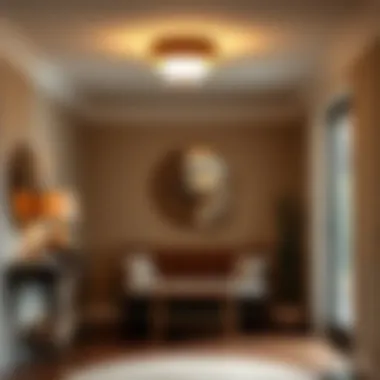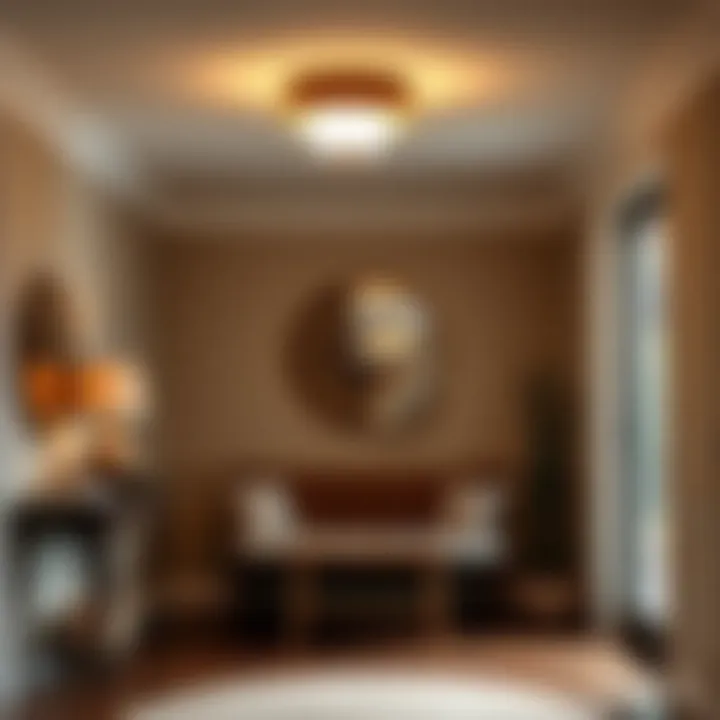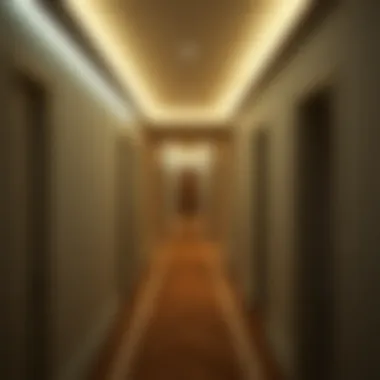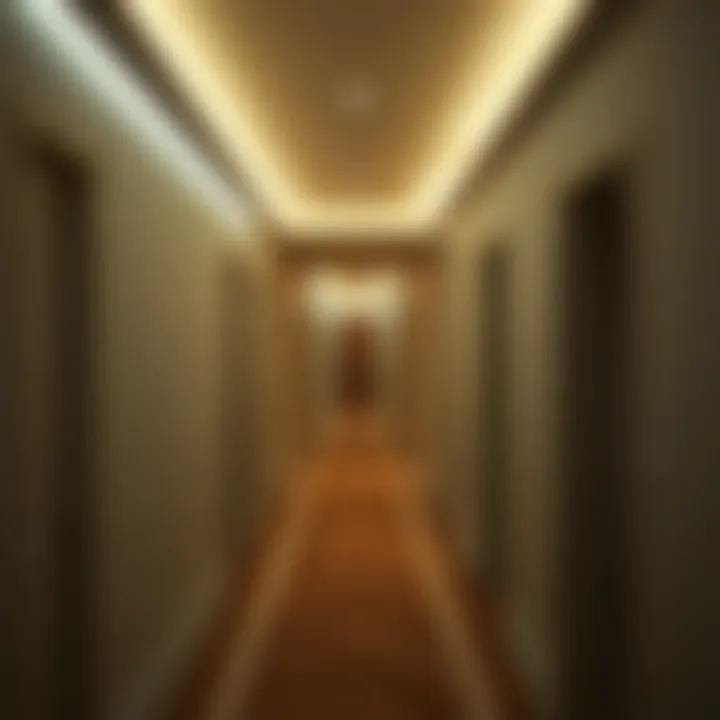Illuminate Your Hallways: Choosing the Right Light Fixtures


Intro
The ambiance of a home conjures feelings of warmth and security; hallways, often overlooked, can dramatically impact this experience. When designing these transitional spaces, the right light fixtures do more than merely illuminate—they set the tone for what lies beyond. Hallways serve as the veins of a home, connecting various rooms and functions, hence deserving thoughtful attention in terms of lighting.
In this guide, we shall unravel the nuances of hallway lighting by exploring styles, installation methods, and efficient options tailored for various aesthetics. Homeowners and designers alike will find practical insights that not only illuminate safety but also enrich the overall atmosphere. By examining both the functional and decorative roles of light fixtures, readers can transform their corridors into inviting passageways that resonate with their home's personality.
"Good lighting is the first step to good design." A well-lit hallway can make the difference between a warm welcome and a dreary passage.
We will dive into the latest trends in light fixtures, practical installation advice, and efficient designs, ensuring you leave with the knowledge to conquer every hallway challenge with flair.
Understanding Hallway Lighting
Lighting doesn’t just play a functional role; it sets the tone, creates an atmosphere, and influences how we navigate through our spaces. Hallways, often overlooked, serve as the arteries of our homes. They connect various rooms and facilitate movement, making their illumination paramount. Effective hallway lighting not only enhances visibility but also adds an aesthetic dimension that ties together the home’s overall design.
The Purpose of Hallway Lighting
The primary function of hallway lighting is, of course, safety. A well-lit hallway reduces the risk of accidents, especially during late-night strolls. When someone is half-asleep, fumbling in the dark can lead to trip hazards or unexpected bumps into walls. Good lighting illuminates potential dangers, guiding your way like a trustworthy friend in the dark.
Moreover, hallway lighting contributes to the home’s ambiance. Think of the style you want: Are you aiming for a cozy, inviting feel or a more modern, sleek vibe? The right fixtures can transform the mood. For instance, soft wall sconces offer a relaxed atmosphere, whereas bright recessed lights can make a narrow space feel airy and open.
- Creates Safety: Helps prevent accidents in dimly lit areas.
- Enhances Aesthetics: Adds beauty to narrow corridors, tying in the design of adjoining rooms.
- Defines Spaces: Guides visitors through the home while highlighting focal points and artwork.
Optimal Illumination Levels
Determining the right level of illumination for hallways can feel like a balancing act. Too much light might resemble an operating room, while too little can turn your passage into a shadowy maze. But how do you hit that sweet spot? Generally, the goal is to provide adequate light without overwhelming glare.
A common suggestion is to aim for a brightness level ranging between 100 to 200 lumens per square meter. Here are a few pointers:
- Use Multiple Lighting Sources: Instead of relying on one overhead fixture, consider a combination of wall sconces, recessed lighting, and even some artwork spotlights. This will create layers of light that can be adjusted as needed.
- Consider the Ceiling Height: Higher ceilings may require additional fixtures or stronger bulbs. Conversely, lower ceilings benefit from fixtures that diffuse light well, preventing harsh shadows.
In essence, achieving optimal illumination is about creating a welcoming atmosphere. It’s not just about what lights up the room—it’s about how it illuminates the path you take through your life, one step at a time.
Types of Light Fixtures for Hallways
Choosing the right kind of light fixture for hallways matters more than one might think. Lighting sets the mood, enhances safety, and can turn a dull corridor into a striking entryway. Different types of fixtures serve various roles and can cater to a range of aesthetic preferences. Understanding these options allows homeowners, designers, and decorators to create spaces that blend functionality with beauty. Here, we dive into distinct types of light fixtures, each with their own unique benefits and considerations.
Flush Mount Fixtures
Flush mount fixtures are the unsung heroes of hallway lighting. These low-profile lights hug the ceiling and provide ample illumination without taking up unnecessary space. They are best suited for hallways with lower ceilings, ensuring that the vertical space feels open and airy rather than cramped.
The simplicity of flush mount fixtures means they blend well with various decor styles, from modern minimalist to traditional elegance. Additionally, they come in a plethora of designs, allowing for a match to the existing aesthetic. One of the key benefits here is their ease of maintenance; dust and grime are less likely to accumulate due to the fixture's height.
Considerations when selecting flush mount fixtures include:
- Size: The diameter should complement the space without overpowering it.
- Color Temperature: Cooler lights can look stark and unwelcoming, while warmer hues create a cozy feel.
Wall Sconces
Wall sconces are wonderfully versatile. Positioned on the wall, they can cast light both upwards and downwards, creating a dramatic effect in any hallway. They are also ideal for narrow corridors where ceiling space is limited. Sconces not only provide light but can act as decorative elements, enhancing the visual interest of the space.
These fixtures can be paired with flush mount lights for layered lighting. This approach helps achieve a well-lit atmosphere while allowing for different moods within the corridor.
When choosing wall sconces, consider:
- Height Placement: Typically, sconces are mounted at eye level to maximize their effect and aesthetics.
- Style: Opt for sconces that reflect the overall theme of the home, whether that be vintage, contemporary, or industrial.


Pendant Lights
Pendant lights bring a touch of elegance and personality to hallway lighting. They hang from the ceiling on a rod or chain and can draw the eye toward specific areas of the corridor, such as artwork or decorative niches. This type of lighting works particularly well in hallways with higher ceilings, allowing for a statement piece that can incorporate unique design elements.
A potential downside is that they can obstruct walkways or headroom if installed incorrectly. Therefore, calculation of the hanging height is crucial.
Tips for selecting pendant lights include:
- Scale of the Fixture: The size should be proportionate to the hallway's width.
- Material and Finish: Choose materials that will seamlessly fit your existing decor while also considering how light will play off different finishes.
Track Lighting
Track lighting provides flexibility, giving homeowners the ability to adjust and direct light where it's needed the most. This can be particularly valuable in long hallways, where certain areas may require more illumination, such as entry points or staircases. With the ability to reposition fixtures along the track, it's akin to having a customizable art gallery of light.
Key considerations include:
- Type of Bulbs: LED options can greatly enhance energy efficiency while providing varying levels of brightness.
- Design Compatibility: Track lighting can adopt a sleek and modern or a more vintage look, depending on the design of the fixtures.
Recessed Lighting
Recessed lighting, or can lights, is installed above the ceiling, providing an unobtrusive light source that doesn't clutter the visual space. This is perfect for areas where ceiling height is important, maintaining an open atmosphere while offering functional lighting. They can be in linear patterns to guide the eye down a hallway or placed to spotlight artwork.
However, careful planning is necessary to avoid light pooling or harsh glares. It's important to consider:
- Spacing: Recessed lights should be evenly spaced based on the wattage and the ceiling height to ensure uniform illumination.
- Dimming Options: Many homeowners opt to include dimmer switches, allowing for control over the ambiance at different times.
Each type of fixture contributes to the overall character of the hallway. By acknowledging these diverse lighting options, homeowners can create thoughtful and engaging spaces.
Design Considerations for Hallway Lighting
When it comes to hallway lighting, many might brush off the design considerations as merely aesthetic choices. However, these details play a pivotal role in blending function with form. Lighting can influence both the ambiance and flow of a space. An inviting atmosphere encourages movement while ensuring safety. Here, we will delve into four key design considerations that should always feature on your radar when planning hallway lighting: style matching, fixture size and scale, light color temperature, and maintenance considerations.
Style Matching with Interior Decor
Selecting light fixtures that harmonize with the existing interior decor is crucial. It's not just about picking something that looks nice; it’s about creating a seamless flow throughout your home. If one opts for ornate sconces in a minimalistic corridor, it could easily disrupt the visual narrative, leaving onlookers scratching their heads.
To align hallway lighting with your decor, consider these points:
- Consistency: Ensure that the fixture's style matches or complements other elements in adjoining rooms.
- Theme: Whether your space embodies modernism, traditional charm, or eclectic flair, your choice of light fixture should echo that visual language.
- Materials and Finishes: Pay attention to the materials used in your fixtures. A polished chrome sconce might clash with rustic wooden accents.
Consistently matching styles can turn your hallway into a thoughtful continuation of your home’s personality rather than an afterthought.
Size and Scale of Fixtures
The dimensions of hallways can vary significantly, which makes the size and scale of light fixtures a pivotal point in the design equation. An oversized chandelier in a narrow corridor might feel cramped while a petite wall sconce in a large hallway could appear lost in space.
When choosing the right scale, consider:
- Ceiling Height: Tall ceilings can accommodate larger fixtures without overwhelming the area.
- Fixture Height: Install wall sconces at eye level for the best aesthetic appeal, while ensuring they’re high enough to avoid obstruction.
- Hierarchy: Consider layering fixtures by combining various types—perhaps a pendant light over a table combined with wall-mounted lights for ambient glow.
Sizing up your fixtures in relation to the hallway's dimensions can lead to a balanced and harmonious atmosphere.
Light Color Temperature
The color temperature of lighting can dramatically transform the vibe of a space. Hallway lighting often benefits from a warmer hue, as it casts a soft glow, making the corridor feel more inviting.
Consider the following aspects:


- Warm versus Cool: Warmer colors (around 2700K-3000K) evoke comfort while cooler tones (4000K-5000K) render a fresher, more sterile ambiance.
- Transition Zones: If the hallway leads into different areas of varying ambiances, you might select a color temperature that helps transition between spaces smoothly.
- Energy Efficiency: Many modern bulbs offer a range of color temperatures—LEDs are not only energy-efficient but available in diverse tones.
Ultimately, the temperature of your hallway lighting should complement the mood you wish to convey while maintaining practicality.
Maintenance and Accessibility
Lastly, maintenance ought not to be swept under the rug when considering hallway lighting. Fixtures that are too high or awkwardly placed can become a hassle to clean.
In thinking about maintenance, reflect on:
- Fixture Design: Choose fixtures that allow for simple bulb replacement and cleaning.
- Location: Avoid hard-to-reach areas that may deter routine maintenance, as neglected lighting can lead to dim and unsafe conditions.
- Durability: Materials that stand the test of time, especially in high-traffic areas, can minimize upkeep and replacements.
Effective maintenance planning leads to sustainable hallway lighting that stays bright and effective over time.
Bottom line: Well-planned design considerations significantly enhance both the function and style of hallway lighting. Matching the fixture style with interior decor, ensuring proper size and scale, selecting the right color temperature, and planning for maintenance are integral to creating a corridor that is not only visually appealing but also practical.
For more information on lighting design, you may find resources on Wikipedia and Britannica.
Energy Efficiency in Hallway Lighting
When it comes to illuminating hallways, energy efficiency plays a crucial role. It’s about more than dimming lights to save a few bucks on that elecricity bill. It’s about making sound choices for a sustainable future. With the right approach, homeowners and designers can create spaces that are visually appealing while being kind to the environment.
Hallway lighting often operates for extended periods, especially in homes with children or frequent guests. This sphere of constant activity highlights the need to utilize energy-effective solutions. Let’s dive into the two prominent options in this arena: LED bulbs and traditional incandescent bulbs, followed by smart systems and dimmers.
LED vs. Traditional Bulbs
Choosing between LED and traditional bulbs can feel like picking apples or oranges sometimes. Each has its perks, but the differences in energy usage are stark. LED bulbs are a no-brainer for energy efficiency. They usually consume about 75% less energy than incandescent lights while lasting up to 25 times longer. The long lifespan can mean less hassle when it comes to replacements and the associated costs.
On the flip side, traditional incandescent bulbs are often less expensive upfront, but their energy demands quickly overshadow those savings. Here is a deeper look at some key factors:
- Lifespan:
- Energy Usage:
- Heat Emission:
- LED: Approximately 15,000-25,000 hours.
- Incandescent: About 1,000 hours.
- LED: Consumes 9-12 watts for an equivalent brightness of a 60-watt incandescent.
- Incandescent: Uses around 60 watts for the same brightness level.
- LED: Generates minimal heat—better for savings and comfort.
- Incandescent: Quite a bit of wasted energy as heat.
It’s clear the scales tip in favor of LEDs when discussing long-term benefits. For any homeowner looking to reduce their energy consumption and costs, swapping traditional bulbs for LEDs might just be the golden ticket.
Dimmers and Smart Systems
In the realm of hallway lighting, dimmers and smart systems are game changers. Imagine being able to tailor the brightness of your lighting according to your needs, time of day, or mood. Dimmers allow for adjustable lighting that can conserve energy without sacrificing comfort.
Using dimmers can reduce energy usage by up to 40%, which, over time, contributes to significant savings. This flexibility is particularly beneficial for hallways, where you might want brighter lights during busy times and softer lights at night.
Smart systems take it a notch higher. These systems can automate lighting based on occupancy, time of day, or even when the sun sets. Imagine your hallway lighting gently turning on as you walk through the door, adjusting its brightness to your current activity. Such features aren’t just convenient; they promote energy savings too.
When you have a well-planned system in place, it limits unnecessary energy consumption. Coupled with energy-efficient bulbs, a combination of dimmers and smart home tech greatly enhances the functionality of hallway lighting.
In summary, considering energy efficiency in hallway lighting isn’t merely about reducing costs; it’s about creating a responsible, comfortable, and stylish space. By exploring LED bulbs and integrating smart systems into the mix, illuminating your hallway becomes more than just a lighting choice—it’s a step toward a brighter, greener future.
Installation and Placement Tips
When it comes to choosing the right light fixtures for your hallway, the installation and placement of these fixtures can significantly influence not only the aesthetic appeal but also the functional performance of the lighting system. Let’s not beat around the bush; a cleverly designed lighting plan can transform a dim corridor into a stylish and safe passageway, allowing for easy navigation and a warm welcome to your home’s interior.


Planning Fixture Locations
Deciding where to position your fixtures is key. It’s essential to consider not just the how, but the where and why behind your choices. Here are some pointers to keep in mind:
- Consider Height: Ideally, light fixtures should be mounted at a height that allows for even light distribution without being directly in sight. For most hallways, placing lights between 80 to 90 inches from the floor tends to be just right, unless your ceilings are exceptionally high.
- Spacing Matters: A smart rule of thumb is to space wall sconces about 6 to 8 feet apart along the hallway. This prevents dark spots and delivers uniform lighting—all while ensuring a balanced look. When planning the layout, measure your corridors; if they are long and narrow, focusing on the path’s center can provide the best results.
- Environmental Considerations: Be mindful of architectural features like arches or windows which may affect where light should go. If the space is short on natural light, you need to get creative. More fixtures or multiple sources of light can provide a brighter environment and make the area feel more open.
"A well-placed light fixture is like a strategic warrior on the battlefield of design—it not only illuminates but also enhances and elevates!"
Wiring Considerations
Well, here’s the nitty-gritty part: wiring. It’s not the easiest task, but it’s certainly crucial for ensuring your lighting operates safely and effectively. Here are a few tips:
- Hire a Pro: If you're not comfortable with electrical work, don’t shy away from hiring a licensed electrician. It’s worth it for safety and compliance with local electrical codes.
- Existing Structures: If you're working with an older home, be aware of the existing wiring. Older wiring may not handle the power requirements of modern fixtures, especially LED setups, which might need a bit of an upgrade.
- Switch Locations: The placement of switches is just as important as the fixtures themselves. Position them conveniently for ease of access, ensuring they are placed at a height where they can easily be reached by adults and children alike. Having multiple switches for long hallways can minimize the need to traverse back and forth.
- Plan for Future Upgrades: As you map out your wiring, think ahead. Incorporating additional outlets or the ability to add dimmers can save you headaches down the road. A little foresight can go a long way!
In summary, when it comes to installing and placing fixtures in hallways, the wisdom lies in careful planning and execution. Not only does it enhance the enjoyment of your space, but it also reflects an attention to detail that any discerning homeowner can appreciate.
Case Studies: Successful Hallway Lighting Designs
Understanding real-world applications of hallway lighting can significantly aid in the design process. By looking at successful case studies, homeowners and designers can gain insight into how specific lighting choices can transform a corridor from a simple passageway into an integral part of a home's character. Such studies serve multiple purposes: they illustrate practical implementations, showcase potential style combinations, and highlight mistakes to avoid. Moreover, they emphasize the balance needed between function and aesthetics—after all, a hallway must be both illuminated sufficiently and styled appropriately.
Modern Minimalist Approaches
In this bustling world, simplicity often speaks volumes, and modern minimalist designs harness that philosophy effectively. A case study within a contemporary apartment showcased how sleek linear lights mounted flush to the ceiling create a clean and unobtrusive look. The key here is a focus on geometric shapes and adequate spacing between each fixture. It's often advised to steer clear of ornate designs, opting instead for monochromatic palettes—think white, black, or uncluttered metals.
Utilizing smart technology can also enhance the minimalist vibe. Integrated motion sensors provide light only when needed, maintaining efficiency while preserving that clean, uncluttered aesthetic. As an added touch, clear glass rods placed strategically along the hallway soften the stark light and introduce a subtle elegance without cluttering the space.
Classic and Traditional Concepts
While modern designs cater to the trend of simplicity, classic and traditional concepts hold their own warmth and familiarity that many still cherish. One particular case highlighted a lovely Victorian home adorned with antique chandeliers and wall sconces. Here, the aim was to maintain the historic integrity while ensuring adequate illumination.
Using warm light bulbs with a color temperature around 2700K enhances the amber glow typical of traditional lighting, making it not just functional, but inviting. To tie everything together, decor elements like crown moldings serve to accentuate the elegance of each fixture. It's crucial in such designs to consider the size and scale of each piece; large chandeliers can overwhelm a narrow hallway, while appropriately sized sconces flanking the wall add to the grandeur without feeling excessive.
Eclectic and Artistic Themes
For those willing to take a bolder step, an eclectic design approach can prove captivating. A notable case involved a hallway that fused various art styles—modern art pieces hung alongside rustic wooden paneling, with wildly different light fixtures. This mix allows for playful combinations. Wall-mounted lights, crafted in mismatched styles, create dynamic focal points amid a landscape of paintings and sculptures.
Colorful light sources, such as lamps with vibrant hues, draw the eye and invite curiosity. The challenge with such a theme lies in achieving cohesion amidst diversity. It's advisable to select one common element—like a consistent finish (say, brushed gold or matte black)—to glue the aesthetic together. Thus, the eclectic thematic approach doesn't end in chaos but rather celebrates the beauty of variety.
In summary, these case studies illustrate that hallway lighting can vary widely depending on personal taste and home style. Adapting successful techniques shared by others allows for both innovation and tradition to coexist, ultimately leading to well-designed spaces.
Epilogue: Selecting the Right Fixture
Choosing the right light fixture for your hallway is more than just a decision based on aesthetics; it’s about achieving a harmonious blend of style, function, and safety. A hallway often serves as a pathway connecting various spaces in a home, making effective lighting essential. It’s the invisible hand that guides you through, ensuring you don’t trip over shoes left by the door or miss the beauty of a well-decorated corner.
When selecting fixtures, consider your personal style. Each piece—be it a flush mount or a pendant—tells a story. A sleek, modern fixture might resonate in a contemporary home, while an ornate chandelier might complement a more classic interior. Yet it’s crucial these choices also align with functionality. A well-lit corridor not only enhances your home’s appeal but can also boost its safety. Think about how much light is necessary to illuminate the space adequately without leaving any dark corners lurking.
Reflecting Personal Style and Functionality
In choosing a fixture, it is vital to consider how it reflects both personal style and practical needs. Everyone has an individual flair, and the fixtures you choose should echo that. For instance, a person who loves the vintage look might select a wall sconce adorned with interesting filigree, while a modernist might lean towards clean lines and minimalist designs.
- Personal preferences:
- What colors do you favor?
- Which shapes speak to you?
With so many options available, it’s crucial to find harmony between beauty and purpose. A light fixture that throws soft light can create a warm, welcoming ambiance but might not be enough in a busy household. Here, layering your lighting might come into play. Using a combination of ceiling fixtures and wall sconces can prove beneficial.
Additionally, think about placement. Emphasizing decorative elements in the hallway can create focal points. For example, positioning lights to highlight artwork or architectural features can pull together the overall aesthetic.
In summary, selecting hallway light fixtures requires more than just picking something that looks good. It’s about creating an experience in your home that melds your personality with functionality. The right fixtures can transform an ordinary hallway into a mesmerizing corridor that beckons you to explore further in what lies beyond. Reflecting both style and safety, your choices will make your hallway a true extension of your home’s personality.
"Lighting is the artistry that paints your spaces, it must sing in harmony with your decor while ensuring safety along the way."
As you embark on your journey of illumination, think wisely, choose creatively, and let each light enhance the beauty of your home.



